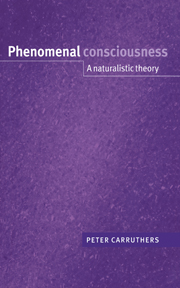Book contents
- Frontmatter
- Contents
- List of figures
- Preface
- 1 Assumptions, distinctions, and a map
- 2 Perspectival, subjective, and worldly facts
- 3 Explanatory gaps and qualia
- 4 Naturalisation and narrow content
- 5 First-order representationalism
- 6 Against first-order representationalism
- 7 Higher-order representationalism: a first defence
- 8 Dispositionalist higher-order thought theory (1): function
- 9 Dispositionalist higher-order thought theory (2): feel
- 10 Phenomenal consciousness and language
- 11 Fragmentary consciousness and the Cartesian theatre
- Conclusion
- References
- Author index
- Subject index
5 - First-order representationalism
Published online by Cambridge University Press: 30 September 2009
- Frontmatter
- Contents
- List of figures
- Preface
- 1 Assumptions, distinctions, and a map
- 2 Perspectival, subjective, and worldly facts
- 3 Explanatory gaps and qualia
- 4 Naturalisation and narrow content
- 5 First-order representationalism
- 6 Against first-order representationalism
- 7 Higher-order representationalism: a first defence
- 8 Dispositionalist higher-order thought theory (1): function
- 9 Dispositionalist higher-order thought theory (2): feel
- 10 Phenomenal consciousness and language
- 11 Fragmentary consciousness and the Cartesian theatre
- Conclusion
- References
- Author index
- Subject index
Summary
In this chapter I shall begin to assess the prospects for a naturalistic explanation of phenomenal consciousness in first-order representational (FOR) terms, focusing particularly upon the accounts presented by Dretske (1995) and Tye (1995). Part of the point of these discussions – let me stress – will be to develop an account of first-order perceptual contents which can then be fed, as a component, into the higher-order theories to be discussed in chapters 7, 8 and 9.
FOR theory: elucidation
In two wonderfully written, lucid, and highly ambitious books, Dretske (1995) and Tye (1995) have independently developed very similar first-order representational (FOR) theories of phenomenal consciousness (see also Kirk, 1994). In both cases the goal is to characterise all of the phenomenal – ‘felt’ – properties of experience in terms of the representational contents of experience (widely individuated). On this view, the difference between an experience of red and an experience of green will be explained as a difference in the properties represented – reflective properties of surfaces, say – in each case. And the difference between a pain and a tickle is similarly explained in representational terms – the difference is said to reside in the different properties (different kinds of disturbance) represented as located in particular regions of the subject's own body.
PANIC states
Both Dretske and Tye maintain that a phenomenally conscious experience is one which is poised to have an impact on the subject's beliefs and practical-reasoning processes in such a way as to guide behaviour.
- Type
- Chapter
- Information
- Phenomenal ConsciousnessA Naturalistic Theory, pp. 114 - 146Publisher: Cambridge University PressPrint publication year: 2000



